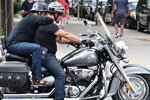How to ride pillion on a motorbike is a common question that most bikers assume. You need to understand the measures, laws, and regulations to follow for a safe ride.
This complete guide will help you solve all your queries about riding pillion on a motorbike.
How to ride pillion on a motorbike?
Follow the measures on how to ride pillion on a motorbike:
Set up the motorbike:

Before you carry any passenger, start the motorbike and ensure it can handle enough weight. Make sure to follow adjustments.
Adjust preload over the rear shock absorber and compensate for the additional weight of a pillion. This requires simple adjustments and involves tightening the cog over the shock.
Make sure to adjust the pressure of the tires. Generally, with the pillion riding on a motorbike, you need to check the manual instructions because each motorbike differs.
Other than that, you need to ensure flipping the footrests of the pillion before you set off.
Suspension adjustment:
Most of the bikes come with the suspension set for average riders weighing around 80kgs. If you weigh less or more, you should adjust your bike with the suspension.
Moreover, the pillion will change the load more significantly. The riders might vary in terms of kgs below or above an average rider weight, but the pillion’s weight might double the difference.
Plus, the center of gravity varies from the back and is much higher, which might upset handling the bike.
Lastly, if your bike comes with suspension adjustments, you should utilize it. In most cases pumping preload over the rear springs might seem enough.
If your motorcycle lacks any adjustment and you still do extra two-up riding, it’s best to fit the adjustable type of rear shock to your bike.
There are other areas too that need adjustments like chains, headlights, and tires. Ensure to consult the manual for optimal tire pressure. Adjust the chain and headlight appropriately.
Moreover, you can adjust and handle anomalies by communicating with the pillion to sit in close approximation. Hence, you both move together with a better focus of the bike and maintain a center of gravity.
But this won’t allow you to move around the seat; instead, you need to adjust the riding style that suits you well in such a situation.
Communication during the ride:

Is there any need for communication during the ride? If you are a newbie or a beginner, the pillion will also be an inexperienced one. Make sure to discuss the points with the pillion and keep yourself calm.
Communicate about dismounting, mounting, braking, or cornering. Also, talk about when the bike stops over the junctions or lights. And while you are moving, make sure to communicate in such a way with the pillion.
The oldest way of communication is by using hand signals before you set off. For instance, double taps over the left shoulder indicate, please stop—however, the new way of communicating with the pillion is through bluetooth headsets that are easily mounted to the helmet.
What gears to wear?
Now when we talk about the gears. For the rider and the pillion, you must wear a complete set of equipment which includes safety gear and the helmet.
You might not have a complete set of leather kits within the garage but ensure the passengers have a complete set of gloves, helmet, protective jacket, and motorbike jeans.
Riding style
You must be wondering which riding style to adopt with a pillion? Adjust the riding style when you ride pillion on a motorbike. Save your knee down in cornering or hard acceleration skills at the time of the solo ride.
Make sure you handle the bike rides smoothly. Plan and anticipate priorly for minimizing the need for gear changes and brakes.
The additional weight makes your bike handling different and reduces performance and efficiency. Ensure you stay aware as the passengers don’t have a complete view of the road ahead, and they won’t anticipate your actions.
As A Driver, Be Careful with The Following:
Changing Gears:
If you are a freshman, you might be unknown with the term “helmet bump.” It occurs when the helmets of the pillion and the rider collide during changing gears.
It usually occurs when the clutch dip over changing gears. It leads to a drop in motorcycle speed and passenger’s natural brace action. This occurs in reaction to the speed, which leads to dipping forward and clashing of helmets.
What you can do in such a situation is to change the gears smoothly. It also helps if you change immediately without any loss of momentum. Practice the technique thoroughly before you plan on riding with a pillion.
Acceleration:
Is acceleration good with a pillion? The pillions won’t like it much. The motorcycle accelerates with a pillion due to additional weight. It leaves a massive traffic gap, especially when overtaking or at junctions.
Do not compensate for such situations through extreme acceleration, as this can be uncomfortable for the pillion’s weight and instability. Smooth, general type of acceleration with complete anticipation of the traffic conditions will make your ride enjoyable.
Braking:
The braking efficiency significantly reduces if you have a pillion at the back, so plan before you stop. Try braking earlier and make use of engine brakes as soon as possible. The pillion’s weight over your bike’s rear wheel can enhance the rear brake’s effectiveness, so try using that more.
Steering
Steering with the pillion on a motorbike might make it sluggish and heavier. Try scanning the road ahead and avoid sudden changes in direction. Slow maneuvers in speed like filtering might seem challenging, so prepare, allowing more space when you ride the bicycle at slow speed.
How To Be a Good Pillion
How to get on the motorcycle?

Most motorcyclists have suffered from a fall if an eager pillion climbs up on the bike without consent.
Allow the rider to get on the bike first; let him stay steady in position with feet placed over the ground. Once he is comfortably set within a stable position, ask him to give the nod.
Now get up on the bike from the left-hand side, next swing the right leg on the bike, and then on the peg. Bring the left leg and shuffle in such a way that your feet are on pegs.
Avoid mounting on the bike like you might sit upon the horse as putting your entire weight over the left peg to pull up might imbalance the motorcycle.
What Should You hold?

There are two options from which you can choose;
- Grab rail- keep the hands behind your back and firmly grip the grab rail.
- Hold on to the rider- next, the pillion can wrap his or her hands around the rider’s waist. Try adopting a firm, relaxed grip so that the bike can move naturally.
Some pillions like using both methods have one hand over the grab rail while the other around the driver’s waist.
While Touring bike at Corners:

If you are riding with a new pillion, they might feel nervous when riding a motorcycle. Motorbikes naturally lean over the corners, so it’s best to follow the bike’s natural leaning and the rider.
Don’t get confused between leaning too far or near; move with the flow and stay relaxed. Lastly, avoid sudden position change.
Slow speed maneuvers:
Pillions can add extra weight over the motorbike, making it harder for the rider to control over slow speed affecting the bike’s balance. So, what you can do is stay relaxed and still.
Acceleration and Brakes:
At the braking time, pillions move forward in close approximation with the driver leading to helmet collision. To prevent this, the rider should anticipate their approach over the roundabouts, junctions, and corners.
It allows the pillion to brace against the rider or the grab rail. You can place a hand over the fuel tank to keep yourself intact.
Acceleration, on the other hand, results in an opposite effect where you are pushed backward. Simultaneously, you need to anticipate the situation wisely and have a firm grip similar to the braking effect.
Stop at Junctions:
Avoid putting your feet down as the rider stops over junctions, roundabouts, or lights. Let the rider balance the bike and take proper control of the situation.
Dismounting:
Make sure to ask the rider before you get off the bike, preventing you, rider, and bike from falling due to a weight change.
FAQs
Will my motorbike easily cope up with the additional pillion weight?
If the motorcycle is suitable for both passengers and comes with rear footpegs, it will easily cope with the pillion weight.
What Should I adjust on my bike to ride a pillion?
Make specific changes in a bike’s setting, like minimizing the passenger’s impact. Try stiffening the spring preload in rear shock to cope with the passenger’s additional weight. Lastly, adjust the brakes according to the pillion’s weight.
What’s the best motorbike for a pillion?
Sports bikes do not always come with a setup that facilitates the pillions. On the other hand, cruisers and tourers keep the comfort of pillions in mind with added power in the engine.
Do I need to alter my riding style with a pillion?
Yes, because you need to work on slow acceleration and lengthened braking distances. You should have intense anticipation for coping with such changes.
Why are bike back seats so high?
Bikes come with high back seats so that there is enhanced efficiency and pedal power of the bike. This allows riders to extend their legs at times of pedaling, avoiding any damage to the knees. Plus, it enhances the center of gravity that improves the handling of bikes.
Conclusion
How to ride pillion on a motorbike might seem daunting for newbies, but once you get used to it and read the full details mentioned above, you’ll end up on a safe journey. So, what are you waiting for? Get set and ready for riding with a pillion.


